肺癌个体化放疗指南 共79页
- 格式:ppt
- 大小:20.74 MB
- 文档页数:79

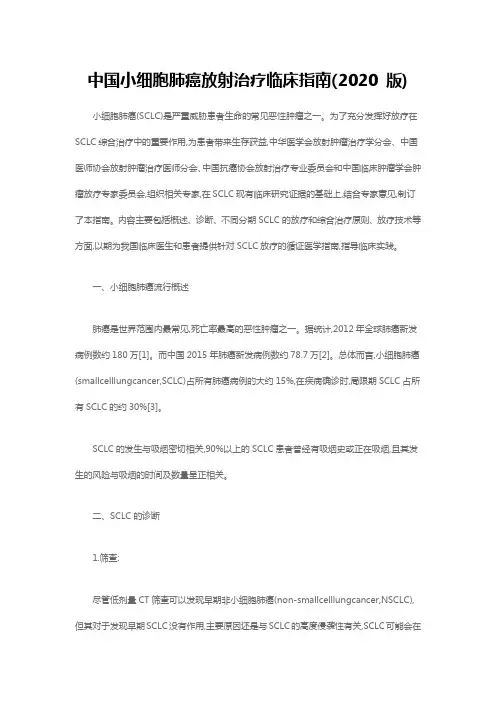
中国小细胞肺癌放射治疗临床指南(2020 版) 小细胞肺癌(SCLC)是严重威胁患者生命的常见恶性肿瘤之一。
为了充分发挥好放疗在SCLC综合治疗中的重要作用,为患者带来生存获益,中华医学会放射肿瘤治疗学分会、中国医师协会放射肿瘤治疗医师分会、中国抗癌协会放射治疗专业委员会和中国临床肿瘤学会肿瘤放疗专家委员会,组织相关专家,在SCLC现有临床研究证据的基础上,结合专家意见,制订了本指南。
内容主要包括概述、诊断、不同分期SCLC的放疗和综合治疗原则、放疗技术等方面,以期为我国临床医生和患者提供针对SCLC放疗的循证医学指南,指导临床实践。
一、小细胞肺癌流行概述肺癌是世界范围内最常见,死亡率最高的恶性肿瘤之一。
据统计,2012年全球肺癌新发病例数约180万[1]。
而中国2015年肺癌新发病例数约78.7万[2]。
总体而言,小细胞肺癌(smallcelllungcancer,SCLC)占所有肺癌病例的大约15%,在疾病确诊时,局限期SCLC占所有SCLC的约30%[3]。
SCLC的发生与吸烟密切相关,90%以上的SCLC患者曾经有吸烟史或正在吸烟,且其发生的风险与吸烟的时间及数量呈正相关。
二、SCLC的诊断1.筛查:尽管低剂量CT筛查可以发现早期非小细胞肺癌(non-smallcelllungcancer,NSCLC),但其对于发现早期SCLC没有作用,主要原因还是与SCLC的高度侵袭性有关,SCLC可能会在1次/年的筛查间歇期快速发展为有症状的晚期病变,因此限制了筛查对于降低死亡率的作用[4-5]。
2.SCLC的临床表现:可由原发病灶引起如咳嗽、气促、咯血、胸痛、声嘶、饮水呛咳、上腔静脉压迫综合征等。
SCLC易转移到脑、肝、骨、肾上腺等器官,可引起相应症状,如头痛、腹胀,转移部位的持续性疼痛等。
肿瘤伴发综合征中抗利尿激素异常分泌综合征可见于约15.0%~22.5%患者,主要表现为虚弱无力、淡漠、嗜睡、味觉障碍等[6-7]。


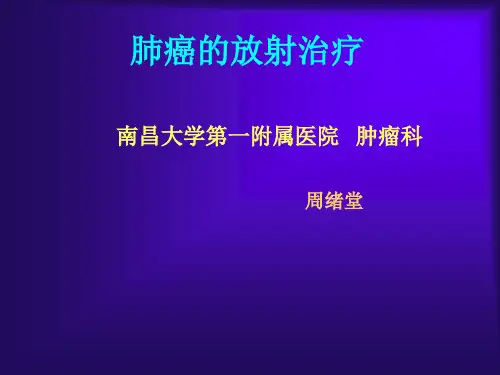
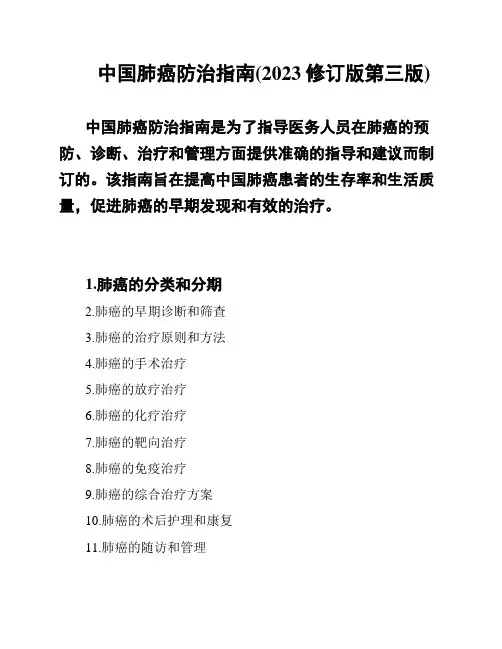
中国肺癌防治指南(2023修订版第三版)
中国肺癌防治指南是为了指导医务人员在肺癌的预防、诊断、治疗和管理方面提供准确的指导和建议而制订的。
该指南旨在提高中国肺癌患者的生存率和生活质量,促进肺癌的早期发现和有效的治疗。
1.肺癌的分类和分期
2.肺癌的早期诊断和筛查
3.肺癌的治疗原则和方法
4.肺癌的手术治疗
5.肺癌的放疗治疗
6.肺癌的化疗治疗
7.肺癌的靶向治疗
8.肺癌的免疫治疗
9.肺癌的综合治疗方案
10.肺癌的术后护理和康复
11.肺癌的随访和管理
2023年修订版第三版的中国肺癌防治指南主要更新了以下内容:
对肺癌的分类和分期进行了进一步细化和完善,以准确判断肺癌的临床特征和预后。
强调了早期诊断和筛查的重要性,提供了更详细和全面的诊断流程和检查指标。
更新了肺癌的治疗原则和方法,加入了新的治疗手段和技术进展。
对手术治疗、放疗治疗、化疗治疗、靶向治疗和免疫治疗进行了更新和完善。
提供了更多的综合治疗方案,以满足不同患者的个体化需求。
强调了术后护理和康复的重要性,为患者的康复提供指导和支持。
更新了随访和管理的要点和方法,以提供长期的监测和支持。
中国肺癌防治指南(2023修订版第三版)是一份权威的指导文件,为医务人员提供了肺癌防治的准确指导和建议。
这份指南的发布对于提高中国肺癌患者的生存率
和生活质量具有积极意义,促进了肺癌的早期发现和有效治疗的实施。
医务人员应遵循该指南的建议,为肺癌患者提供高质量的医疗服务和关怀。
以上内容仅为简介,详细内容请参阅《中国肺癌防治指南(2023修订版第三版)》)。
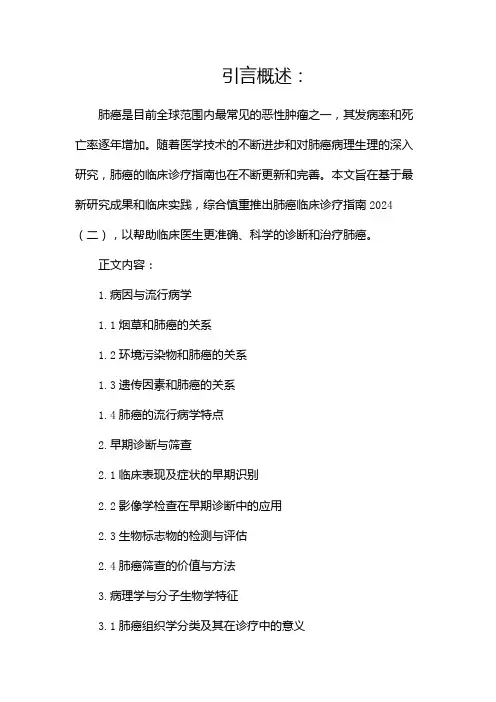
引言概述:肺癌是目前全球范围内最常见的恶性肿瘤之一,其发病率和死亡率逐年增加。
随着医学技术的不断进步和对肺癌病理生理的深入研究,肺癌的临床诊疗指南也在不断更新和完善。
本文旨在基于最新研究成果和临床实践,综合慎重推出肺癌临床诊疗指南2024(二),以帮助临床医生更准确、科学的诊断和治疗肺癌。
正文内容:1.病因与流行病学1.1烟草和肺癌的关系1.2环境污染物和肺癌的关系1.3遗传因素和肺癌的关系1.4肺癌的流行病学特点2.早期诊断与筛查2.1临床表现及症状的早期识别2.2影像学检查在早期诊断中的应用2.3生物标志物的检测与评估2.4肺癌筛查的价值与方法3.病理学与分子生物学特征3.1肺癌组织学分类及其在诊疗中的意义3.2肺癌分子生物学分类及其在靶向治疗中的应用3.3微环境与肿瘤免疫治疗3.4小细胞肺癌的病理学特征与治疗策略4.综合治疗及个体化治疗4.1手术治疗的适应症与技术进展4.2放射治疗在肺癌治疗中的应用4.3化学治疗的选择与应用4.4靶向治疗的研究进展与应用4.5免疫治疗的发展与应用5.肺癌的并发症管理与护理5.1肺癌相关的肺炎与呼吸功能管理5.2肺癌相关的胸腔积液与胸腔引流5.3肺癌相关的疼痛管理与姑息治疗5.4肺癌合并的心血管疾病管理与干预5.5肺癌患者的心理护理与社会支持总结:肺癌临床诊疗指南2024(二)根据最新的临床研究和实践指导,对肺癌的病因与流行病学、早期诊断与筛查、病理学与分子生物学特征、综合治疗及个体化治疗、肺癌的并发症管理与护理等方面进行了详细阐述。
该指南旨在帮助临床医生准确诊断肺癌,合理选择最佳治疗方案,提高肺癌的治疗效果和生存率。
由于肺癌的复杂性及个体差异性,治疗方案应根据患者具体情况进行个体化调整。
未来,随着技术的不断创新以及对肺癌病理生理的进一步研究,肺癌的临床诊疗指南还将继续更新和完善,以更好地满足患者的需求。
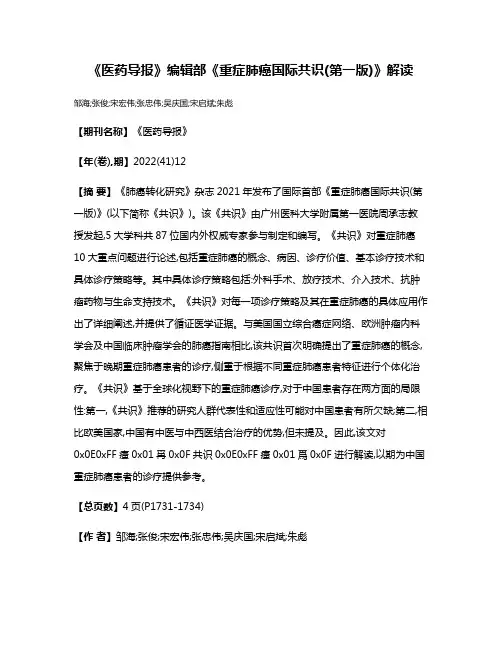
《医药导报》编辑部《重症肺癌国际共识(第一版)》解读邹海;张俊;宋宏伟;张忠伟;吴庆国;宋启斌;朱彪【期刊名称】《医药导报》【年(卷),期】2022(41)12【摘要】《肺癌转化研究》杂志2021年发布了国际首部《重症肺癌国际共识(第一版)》(以下简称《共识》)。
该《共识》由广州医科大学附属第一医院周承志教授发起,5大学科共87位国内外权威专家参与制定和编写。
《共识》对重症肺癌10大重点问题进行论述,包括重症肺癌的概念、病因、诊疗价值、基本诊疗技术和具体诊疗策略等。
其中具体诊疗策略包括:外科手术、放疗技术、介入技术、抗肿瘤药物与生命支持技术。
《共识》对每一项诊疗策略及其在重症肺癌的具体应用作出了详细阐述,并提供了循证医学证据。
与美国国立综合癌症网络、欧洲肿瘤内科学会及中国临床肿瘤学会的肺癌指南相比,该共识首次明确提出了重症肺癌的概念,聚焦于晚期重症肺癌患者的诊疗,侧重于根据不同重症肺癌患者特征进行个体化治疗。
《共识》基于全球化视野下的重症肺癌诊疗,对于中国患者存在两方面的局限性:第一,《共识》推荐的研究人群代表性和适应性可能对中国患者有所欠缺;第二,相比欧美国家,中国有中医与中西医结合治疗的优势,但未提及。
因此,该文对0x0E0xFF瘙0x01爯0x0F共识0x0E0xFF瘙0x01爲0x0F进行解读,以期为中国重症肺癌患者的诊疗提供参考。
【总页数】4页(P1731-1734)【作者】邹海;张俊;宋宏伟;张忠伟;吴庆国;宋启斌;朱彪【作者单位】复旦大学附属肿瘤医院肿瘤危重症医学科;复旦大学肿瘤学系;上海中医药大学附属龙华医院呼吸与危重症医学科;上海市中医院急诊重症监护室;上海市公共卫生临床中心呼吸与危重症医学科;武汉大学人民医院肿瘤中心【正文语种】中文【中图分类】R734.2【相关文献】1.神经重症监护病房防控新型冠状病毒感染专家共识(第一版)2.宏基因组学测序技术在中重症感染中的临床应用专家共识(第一版)3.宏基因组学测序技术在中重症感染中的临床应用专家共识(第一版)4.2020年美国《重症医学会关于重症后幸存者远期损害的预测和识别国际共识》解读5.中国医药卫生“核心期刊”标准专家共识(第一版)因版权原因,仅展示原文概要,查看原文内容请购买。
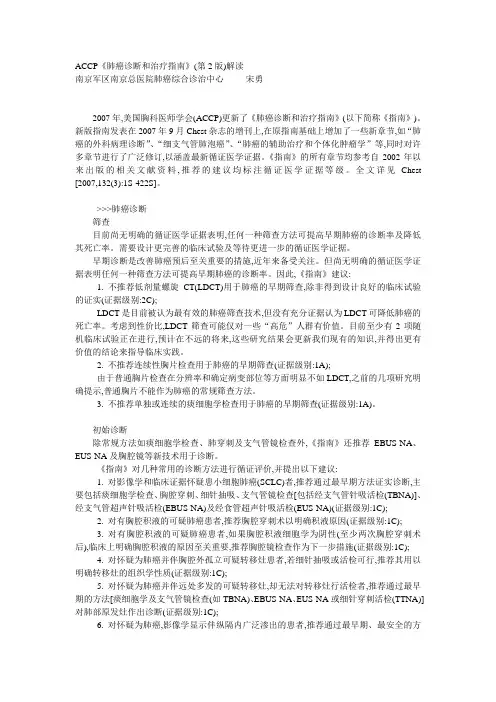
ACCP《肺癌诊断和治疗指南》(第2版)解读南京军区南京总医院肺癌综合诊治中心宋勇--------------------------------------------------------------------------------2007年,美国胸科医师学会(ACCP)更新了《肺癌诊断和治疗指南》(以下简称《指南》)。
新版指南发表在2007年9月Chest杂志的增刊上,在原指南基础上增加了一些新章节,如“肺癌的外科病理诊断”、“细支气管肺泡癌”、“肺癌的辅助治疗和个体化肿瘤学”等,同时对许多章节进行了广泛修订,以涵盖最新循证医学证据。
《指南》的所有章节均参考自2002年以来出版的相关文献资料,推荐的建议均标注循证医学证据等级。
全文详见Chest [2007,132(3):1S-422S]。
>>>肺癌诊断筛查目前尚无明确的循证医学证据表明,任何一种筛查方法可提高早期肺癌的诊断率及降低其死亡率。
需要设计更完善的临床试验及等待更进一步的循证医学证据。
早期诊断是改善肺癌预后至关重要的措施,近年来备受关注。
但尚无明确的循证医学证据表明任何一种筛查方法可提高早期肺癌的诊断率。
因此,《指南》建议:1. 不推荐低剂量螺旋CT(LDCT)用于肺癌的早期筛查,除非得到设计良好的临床试验的证实(证据级别:2C);LDCT是目前被认为最有效的肺癌筛查技术,但没有充分证据认为LDCT可降低肺癌的死亡率。
考虑到性价比,LDCT筛查可能仅对一些“高危”人群有价值。
目前至少有2项随机临床试验正在进行,预计在不远的将来,这些研究结果会更新我们现有的知识,并得出更有价值的结论来指导临床实践。
2. 不推荐连续性胸片检查用于肺癌的早期筛查(证据级别:1A);由于普通胸片检查在分辨率和确定病变部位等方面明显不如LDCT,之前的几项研究明确提示,普通胸片不能作为肺癌的常规筛查方法。
3. 不推荐单独或连续的痰细胞学检查用于肺癌的早期筛查(证据级别:1A)。


RESULTSKQ1: What is the ideal external beam dose fraction-ation for the curative-intent treatment o f locally advanced non-small cell lung cancer with radiation therapy alone?对于局部进展期肺癌根治性单纯性放疗的最佳剂量?Guideline StatementsA. Radiotherapy alone has been shown to be supe-rior to observation strategies or chemotherapy alone for LA NSCLC in terms of overall survival but at the cost of treatment-related side effects s uch as esophagitis and pneumonitis (MQE, recom-mendation rated as “Strong”).B. Radiotherapy alone may be used as definitive radical treatment for patients with LA NSCLC w ho are ineligible for combined modality therapy (i.e. due to poor performance status, medical com orbidity, extensive weight loss, and/or patient preferences) but with a tradeoff of survival for improved treatment tolerability (HQE, recommen-dation rated as “Strong”).C.In the context of conventionally fractionated radio-therapy, a minimum dose of 60 Gy is recom mend-ed to optimize important clinical outcomes such as local control (HQE, recommendation rat ed as “Strong”).D. Altered fractionation schedules that have been explored in the medical literature include hyperf ractionation (lower dose per fraction over the standard treatment duration), accelerated fractionatio n (con-ventional fraction size and same total dose, given in a shorter period of time), accelerated hyperfrac-tionation (combination of these two), and hypo-fractionation (higher dose per fraction a nd fewer fractions). (No evidence rating, recommenda-tion rated as “Strong”).E.Specific altered fractionation schemes that have been investigated in various comparative effec-tiveness research investigations (including ran-domized controlled trials) include 45 Gy/15 frac-tio ns (hypofractionation), 69.6 Gy/58 fractions BID (hyperfractionation), 54 Gy/36 fractions TID ove r 12 consecutive days (CHART, accelerated hy-perfractionation), and 60 Gy/40 fractions TID over 18 days (CHARTWEL, accelerated hyperfraction-ation). (No evidence rating, recommendation ra ted as “Strong”)KQ2: What is the ideal external beam dose fraction-ation for the curative-intent treatment of locall y advanced non-small cell lung cancer with chemora-diotherapy?对于局部进展期肺癌根治性同期放化疗的最佳剂量?Guideline StatementsA. The standard thoracic radiotherapy dose-fraction-ation for patients treated with concurrent che mo-therapy is 60 Gy given in 2 Gy once daily fractions over 6 weeks (MQE, recommendation rate d as “Strong”).B. Dose escalation beyond 60 Gy with conventional fractionation has not been demonstrated to b e as-sociated with any clinical benefits including over-all survival (MQE, recommendation rated a s “Strong”).C. Hyperfractionated radiotherapy regimens that do not result in acceleration of the treatment cou rse, even though the total nominal radiotherapy dose may be modestly increased, do not appear t o im-prove outcomes compared with conventionally fractionated therapy (MQE, recommendatio n rated as “Strong”).D.The optimal thoracic radiotherapy regimen for patients receiving sequential chemotherapy and r adiotherapy is not known; however results from the CHARTWEL and HART phase III studies sug -gest that increasing the biologic equivalent dose by using accelerated hyperfractionated radiotherapy may be of benefit following induction chemother-apy in locally advanced non-small cell lun g cancer (MQE, recommendation rated as “Strong”).E. Although the impact of increasing the predicted bi-ologic equivalent dose via accelerated radio therapy regimens is not clear, further study of accelerated hypofractionated regimens is of interes t to opti-mize the therapeutic ratio of treatment, particularly in the context of advanced imaging, ra diotherapy planning, and treatment delivery. (No evidence rating, recommendation rated as “Stro ng”)KQ3: What is the ideal timing of external beam radiation therapy in relation to systemic che mo-therapy for the curative-intent treatment of locally advanced non-small cell lung cancer? 对于局部进展期肺癌根治性放-化疗的最佳顺序?Guideline StatementsA. There is phase III evidence demonstrating improved overall survival, local control, and respons e rate associated with concurrent chemoradiation when compared against sequential chemotherap y fol-lowed by radiation (HQE, recommendation rated as “Strong”).B. There is no proven role for the routine use of induction chemotherapy prior to chemoradiothera py, although, this treatment paradigm can be considered for the management of bulky tumors to all ow for radical planning after chemotherapy response (MQE, recommendation rated as “Strong”).C.There are no phase III data specifically supporting the role for consolidation chemotherapy afte r chemoradiotherapy for the improvement of overall survival; however, this treatment is still routi nely given to manage potential micrometastatic disease particularly if full systemic chemotherap y doses were not delivered during radiotherapy (LQE, rec-ommendation rated as “Strong”).D.For patients that cannot tolerate concurrent chemo-radiotherapy, sequential chemotherapy follo wed by radical radiation has been shown to be associ-ated with an overall survival benefit when c om-pared to radiotherapy alone (HQE, recommenda-tion rated as “Strong”).E. The ideal concurrent chemotherapy regimen has not been determined; however, the two most c om-mon regimens (cisplatin/etoposide and carbopla-tin/paclitaxel) are the subject of a complete d phase III clinical trial (NCT01494558). (No evidence rating, recommendation rated as “Stron g”)KQ4: What are the indications for adjuvant postoperative radiotherapy for the curative-inte nt treatment of locally advanced non-small cell lung cancer?辅助放疗的适应症:Guideline StatementsA. Phase III studies and meta-analyses of postopera-tive radiotherapy (PORT) in completely resect ed (R0) LA NSCLC with N2 disease suggest that its addition to surgery does not improve overall s ur-vival but may improve local control when com-pared to observation strategies (MQE, recomme n-dation rated as “Strong”).B. Phase III studies and meta-analyses of PORT in completely resected (R0) LA NSCLC with N0 -1 disease demonstrate inferior survival when com-pared to observation strategies; therefore, POR T therapy for this patient population is not routinely recommended. (MQE, recommendation rate d as “Strong”).C. Since level 1 evidence supports the administration of adjuvant chemotherapy for completely res ected (R0) LA NSCLC based on improvements in over-all survival compared to patients on observ ation, any PORT therapy should be delivered sequentially after chemotherapy in order not to interf ere with standard of care chemotherapy (LQE, recommen-dation rated as “Strong”).D. For patients receiving adjuvant PORT for R0 dis-ease, conventionally fractionated doses in th e range of 50 Gy to 54 Gy (in 1.8 Gy-2.0 Gy/day) should be utilized (LQE, recommendation rate d as “Strong”).E. Patients with microscopic residual (R1) primary disease (i.e., positive margin) and/or microsco pic (i.e., extra-capsular extension) nodal disease may be appropriate candidates for PORT (given e ither concurrently or sequentially with chemotherapy) with conventionally fractionated doses in th e range of 54 Gy to 60 Gy (in 1.8 Gy-2.0 Gy/day fraction size) in order to improve local control (L QE, rec-ommendation rated as “Strong”).F. Patients with gross residual primary and/or mac-roscopic nodal (R2) disease of LA NSCLC ma y be appropriate candidates for PORT (given either concurrently or sequentially with chemotherap y) with conventionally fractionated doses of at least 60 Gy (in 1.8-2.0 Gy/day fraction size) in ord er to improve local control (LQE, recommendation rated as “Strong”).KQ5: When is neoadjuvant radiotherapy prior to surgery indicated for the curative-intent treatmen t of locally advanced non-small cell lung cancer?新辅助放疗的适应症?Guideline StatementsA. There is no level I evidence recommending the use of induction radiotherapy (or chemoradioth erapy) followed by surgery for patients with resectable stage III NSCLC (HQE, recommendatio n rated as “Strong”).B. In those patients who are selected for trimodality approach, preoperatively planned lobectom y (as opposed to pneumonectomy), based on best surgi-cal judgment is preferable since it was asso ciated with survival benefit in the exploratory post-hoc INT 0139 analysis (MQE, recommendatio n rat-ed as “Strong”).C. No definitive statement can be made about best patient selection criteria for the trimodality the rapy, although no weight loss, female gender, and one (vs. more) involved nodal stations were ass ociated with improved outcome in INT 0139 (MQE, rec-ommendation rated as “Strong”).D. The ideal preoperative radiotherapy dose is cur-rently not known; however, a minimum of 45 Gy should be delivered consistent with the INT 0139 trial (LQE, recommendation rated as “Str ong”).E. Preoperative conventionally fractionated doses up to 60 Gy (in 2 Gy/day) may be associated w ith rea-sonable mediastinal clearance rates, although no significant correlation with improved over all sur-vival has been demonstrated (LQE, recommenda-tion rated as “Strong”).。